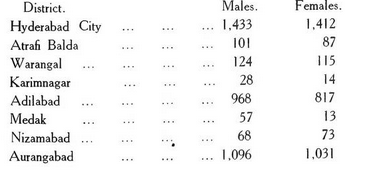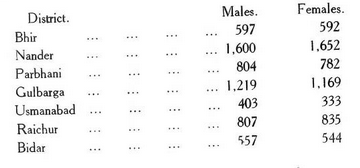Gavli: Deccan
Contents |
Gavli
This article is an extract from THE CASTES AND TRIBES OF H. E. H. THE NIZAM'S DOMINIONS BY SYED SIRAJ UL HASSAN Of Merton College, Oxford, Trinity College, Dublin, and Middle Temple, London. One of the Judges of H. E. H. the Nizam's High Court of Judicature : Lately Director of Public Instruction. BOMBAY THE TlMES PRESS 1920 Indpaedia is an archive. It neither agrees nor disagrees |
Gavli — a pastoral caste found in all the Marathawada districts and in some parts of Telingana. The Gavlis have no traditions and cannot give any account of their origin, nor of their former settlement. They are strong, dark and well made. It is possible that they may be an offshoot from the great Lingayit community, differentiated by keeping herds of cattle and taking to pastoral habits.
Internal Structure
The Gavlis are divided into two sub- castes, Nagarkar and Vajarkar, which are evidently of the territorial type. The members of these sub-castes interdine but do not inter- marry. Each of these is further divided into a number of exogamous sections, some of which are given below as specimens : —
Khedkar.
Taitankar.
Punekar.
Mardkar.
Nizamshai.
Avasekar.
Bhaganagari.
Hatdurkar.
Bajirao.
Ganjewale (hemp).
Divate (torch).
Langote (rag).
Paraswari.
Ambarkhane.
Sevate.
Alankhane.
Dhamkade.
Pharadkhane.
Atrunkarin.
Khandarkar.
Katikar.
Baride.
Nandarkar.
Aurangabade.
Bahirwade.
Godulkar.
Shahpurkar.
Jhade (tree).
Dahiwade (curds).
Landge (wolf).
Goakhore.
Devrishi.
Mahankale.
Pathait.
Bhakare.
Mongle.
Shelar.
Chankade.
Marriage
Infant marriage is practised by the caste, girls being married between the ages of two and ten years. Polygamy is permitted, without any limit being imposed on the number of wives a man may have. The marriage ceremony is of the type common among other Lingayit castes. A bride-price varying from Rs. 50 to Rs. 200 is paid to the father of the bride. The marriage takes place at night. After the bride has been selected, the father of the bridegroom goes to her house and presents her with jewels and new clothes. On this occasion a feast is given by the bride's people in confirmation of the match. On the appointed day, the bridegroom, mounted oi* a bullock, goes in procession to the bride's house and is received at the entrance by the bride's mother, who waves a piece of bread round his head. The bride and bridegroom are seated on low wooden stools, the bride being on the left hand of the bride- groom. Five metal pots are arranged about them, forming a square, and a man goes five times round them, first keeping them always on his right hand, and then as many times again keeping them on his left. Vhile he is making the circuits, he encircles the pots with a raw cotton thread. Both Brahmans and Jangams are called in to conduct the ceremony, who recite mantras, or sacred texts, and throw coloured rice on the bridal pair. This is deemed to be the binding portion of the ceremony. The scarves of the bridal pair are tied in a knot and their feet are washed with water and milk. The bride's right hand is then placed on the right hand of the bridegroom and the father of the bride puts a rupee and a quarter into her hand, which she drops into that of the bridegroom. This completes the giving away of the bride {Kanyadan) and his acceptance of her by the bridegroom. The two sets of cotton thread are then taken off from the pots and one is tied as kflnkanam on the wrist of the bride and the other on that of the bridegroom. After Ganesh and Kalash (water pot) have been worshipped the bridal pair are smeared with turmeric and oil and the ceremony is closed. The officiating Brahman and Jangam claim their fees and retire to their homes.
Widow-Marriage
The Gavjis allow a widow to marry again and impose no restrictions on her choice of a second husband. The widow, before her marriage, is, however, required to give up her children, both male and female, to her late husband's family. The ceremony in use at the marriage of a widow is a very simple one and closely conforms to that among the Maratha Kunbis, both Brahmans and Jangams officiating as priests. Divorce is permitted, with the sanction of the caste Pancha^at, and divorced wives are allowed to marry again by the same rite as widows.
Religion
In respect of religious and ceremonial observances, the Gavlis generally conform to the usages of the Lingayit sect. Like other Lingayits, they wear a lingum, the phallic emblem of the god Shiva, round their necks and worship it daily with offerings of flowers and food before they dine. No Gavli, so long as he lives, can part with this symbol without incurring expulsion from his caste. Their special deity is Mahadev, whom they worship on festive occasions with offerings of flowers and fruit and in whose honour they observe a fast on Mahashivratra, or the 14th of the dark half of Magh (April) and on every Monday in the month of Shravana (August). They pay reverence also to Khandoba, Naroba, Bhavani of Tuljapur, Ganapati and other gods of the Hindu pantheon, and make pilgrim- ages to Pandharpur, Tuljapur, Kondanpur, Jejuri, Alandi and Benares. They call in Jangams, the priests of the Lingayits, at their birth and funeral ceremonies, while Brahmans are employed to con- duct their marriages. Their religion, in fact, is a mixture of Linga- yitism and Hinduism, as practised by the middle classes of Hindu society of Maharashtra. Ancestral worship prevails strongly and silver and brass impressions representing departed ancestors are placed in the god's room and worshipped by burning frankincense and cam- phor before them and with offerings of flowers, fruit and boiled rice.
Child-Birth
A Lingayit woman, after childbirth, is unclean for ten days. On the eleventh day, the mother and child are bathed and their foreheads are smeared with mhhuti (sacred ashes) by a Jangam and they are then free from impurity. Finally, the Jangam brings a new lingum, worships it and either ties it round the child's neck, or hands it to the mother to be kept till the child is twelve years old.
Disposal Of the Dead
The dead are buried in a sitting pos- ture facing the east. When a person dies, the corpse is seated in a wooden frame (makhar), its forehead is smeared with oibhuU and it is carried to the grave on the shoulders of four men. After the body is lowered into the grave, it is filled in with earth and salt, and the Jangam, standing over the mound of earth raised over it, blows the conch shell, intimating that the soul of the deceased has reached Kailas (Shiva's abode). He is then dragged down by the chief mourner and paid hii fees. Mourning is observed for three days only and on the third day a feast is generally given to the members of the caste.
Social Status
The Gavlis rank higher, socially, than the Maratha Kunbis, and are equal to those groups of the Lingayits who have undergone no DiJfsha (initiation ceremony) and with whom Gavlis will eat both kflchi (uncooked) and pakk' (cooked) food and smoke from the same hookah. All kinds of animal food are strictly prohibited, and the members of the caste also abstain from indulging in strong drink.
Occupation
The large majority of the caste find employment as cowherds and comparatively few have taken to agriculture. They purchase cow buffaloes from Berar at prices varying from Rs. 30 to Rs. 120 and cows at from Rs. 20 to Rs. 60. Their women help them in selling milk, butter, curds and whey, and in making and sell- ing cowdung cakes. The children tend the herds of cows and buffaloes belonging to themselves and other people and drive them out to pasture.
Distribution The following statement shows the number and distribution of the Gavlis in 1911 : —

